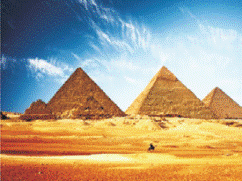A. Look at the picture of a unique Belarusian rite1 of the Kolyady Tsars. How is it related to UNESCO? Read and find out.
Культурные связи Беларуси и страны изучаемого языка
A. Look at the places. What are they? Where are they? What do they have in common?







B. Read the information from UNESCO site and check your guesses.
Heritage is our gift from the past, what we live with today, and what we pass on to future generations. Our cultural and natural heritage are both irreplaceable sources of life and inspiration. Places as unique and diverse as the Pyramids of Egypt, the Great Barrier Reef in Australia, and Stonehenge in the UK make up our world’s heritage. The World Heritage List includes 981 properties which are considered to have outstanding universal value. Many Belarusian architectural monuments and cultural figures are acknowledged global treasures. Sixty years ago, Belarus joined UNESCO and, owing to co-operation with this organisation, people from all over the world are aware of our cultural monuments and outstanding personalities. At the moment, UNESCO’s prestigious World Heritage List includes the Belovezhskaya Pushcha National Park, the Mir Castle Complex, an architectural-cultural complex of the Radziwills’ former residence in Nesvizh, and the Struve Arc, a trans-border object which topographic points located all over Belarus. Staying under UNESCO protection guarantees them safe-keeping and integrity for many years. Moreover, they are likely to attract tourists and scientists from different countries.
A. Reconstruct the questions about the two Belarusian world heritage sites. Mind the Active and Passive Voices.
The Mir Castle Complex
1. When / it / build?
2. What families / it / belong to?
3. When / it / badly damaged?
4. When / the park / appear?
5. What / happen to / the castle / during World War II?
The Complex of the Radziwill Family at Nesvizh
1. When / it / build / ?
2. How long / belong to / the Radziwills?
3. When / the park / design?
4. How / the castle / use / by the Germans?
5. What / the fire / destroy / in 2002?
B. Listen to the guide and answer the questions.
C. Read the text about another Belarusian World Heritage site – the Struve Arc. Some information is missing.
Write questions and then ask them to the teacher to complete the text.
Struve Geodetic Arc
The Struve Arc is a chain of topographic points stretching from Hammerfest in Norway to the Black Sea, through 10 countries and over (1) … km. These are points of a survey, carried out between (2) 18… and 18… by the astronomer Friedrich Georg Wilhelm Struve, which represented the first accurate measuring of a long segment of a meridian. The defeat of Napoleon, followed by the Congress of Vienna and the decision in 1815 to establish (3) … in Europe, required accurate mapping. These needs were strongly felt in Russia, where Tsar (4) … provided the astronomer Wilhelm Struve with all the resources for his project for a new, long geodetic arc. Struve, who was working at (5) …, decided that the arc would follow a line of longitude (meridian) passing through the observatory of the university. This arc helped to establish (6) … of the planet and marked an important step in the development of earth sciences and topographic mapping. It is an extraordinary example of scientific collaboration among scientists from different countries and of collaboration between monarchs for a scientific cause. The World Heritage site consists of (7) … of the original station points – four points in Norway, four in Sweden, six in Finland, one in Russia, three in Estonia, two in Latvia, three in Lithuania, (8) … in Belarus, one in Moldova, and four in Ukraine.
a. Look at the picture of a unique Belarusian rite1 of the Kolyady Tsars. How is it related to UNESCO? Read and find out.
Recently UNESCO has begun to document the world’s Intangible2 Cultural Heritage which includes “traditions or living expressions inherited from our ancestors and passed on to our descendants, such as oral traditions, performing arts, social practices, rituals, festive events, knowledge, and practices concerning nature and the universe or the knowledge and skills to produce traditional
crafts”.
In 2009, the unique Belarusian rite of the Kolyady Tsars, which is performed only in the village of Semezhevo (Kopyl District, Minsk Oblast), was added to the UNESCO List of Intangible Cultural Heritage.